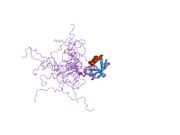Biology:UBQLN2
 Generic protein structure example |
Ubiquilin-2 is a protein that in humans is encoded by the UBQLN2 gene.[1][2]
Function
This gene encodes a ubiquitin-like protein (ubiquilin) that shares high degree of similarity with related products in yeast, rat and frog. Ubiquilins contain a N-terminal ubiquitin-like domain and a C-terminal ubiquitin-associated domain. They physically associate with both proteasomes and ubiquitin ligases, and are thus thought to functionally link the ubiquitination machinery to the proteasome to effect in vivo protein degradation. This ubiquilin has also been shown to bind the ATPase domain of the Hsp70-like Stch protein.[2]
Similarity to other proteins
Human UBQLN2 shares a high degree of similarity with related ubiquilins including UBQLN1 and UBQLN4.[3]
Clinical significance
In a small proportion of familial amyotrophic lateral sclerosis (fALS), the UBQLN2 gene is mutated, causing formation of a non-functional Ubiquilin 2 enzyme. This non-functioning enzyme leads to the accumulation of ubiquinated proteins in the lower motor neurons and upper corticospinal motor neurons, due to the fact that ubiquilin 2 normally degrades these ubiquinated proteins, but cannot if the ALS mutation is present.Cite error: Closing </ref> missing for <ref> tag and UBE3A.[4]
References
- ↑ "A family of ubiquitin-like proteins binds the ATPase domain of Hsp70-like Stch". FEBS Lett 467 (2–3): 348–55. Mar 2000. doi:10.1016/S0014-5793(00)01135-2. PMID 10675567. https://zenodo.org/record/1259585.
- ↑ 2.0 2.1 "Entrez Gene: UBQLN2 ubiquilin 2". https://www.ncbi.nlm.nih.gov/sites/entrez?Db=gene&Cmd=ShowDetailView&TermToSearch=29978.
- ↑ Marín I (March 2014). "The ubiquilin gene family: evolutionary patterns and functional insights". BMC Evol Biol 14: 63. doi:10.1186/1471-2148-14-63. PMID 24674348.
- ↑ "The hPLIC proteins may provide a link between the ubiquitination machinery and the proteasome". Mol. Cell 6 (2): 409–19. August 2000. doi:10.1016/S1097-2765(00)00040-X. PMID 10983987.
Further reading
- Ueki N; Oda T; Kondo M et al. (1999). "Selection system for genes encoding nuclear-targeted proteins". Nat. Biotechnol. 16 (13): 1338–42. doi:10.1038/4315. PMID 9853615.
- "Assignment of ubiquilin2 (UBQLN2) to human chromosome xp11. 23→p11.1 by GeneBridge radiation hybrids". Cytogenet. Cell Genet. 89 (1–2): 116–7. 2000. doi:10.1159/000015588. PMID 10894951.
- Kleijnen MF; Shih AH; Zhou P et al. (2000). "The hPLIC proteins may provide a link between the ubiquitination machinery and the proteasome". Mol. Cell 6 (2): 409–19. doi:10.1016/S1097-2765(00)00040-X. PMID 10983987.
- Murillas R; Simms KS; Hatakeyama S et al. (2002). "Identification of developmentally expressed proteins that functionally interact with Nedd4 ubiquitin ligase". J. Biol. Chem. 277 (4): 2897–907. doi:10.1074/jbc.M110047200. PMID 11717310.
- Walters KJ; Kleijnen MF; Goh AM et al. (2002). "Structural studies of the interaction between ubiquitin family proteins and proteasome subunit S5a". Biochemistry 41 (6): 1767–77. doi:10.1021/bi011892y. PMID 11827521.
- "Identification of ubiquitin-like protein-binding subunits of the 26S proteasome". Biochem. Biophys. Res. Commun. 296 (4): 813–9. 2002. doi:10.1016/S0006-291X(02)02002-8. PMID 12200120.
- Strausberg RL; Feingold EA; Grouse LH et al. (2003). "Generation and initial analysis of more than 15,000 full-length human and mouse cDNA sequences". Proc. Natl. Acad. Sci. U.S.A. 99 (26): 16899–903. doi:10.1073/pnas.242603899. PMID 12477932. Bibcode: 2002PNAS...9916899M.
- "The ubiquitin-associated domain of hPLIC-2 interacts with the proteasome". Mol. Biol. Cell 14 (9): 3868–75. 2004. doi:10.1091/mbc.E02-11-0766. PMID 12972570.
- Colland F; Jacq X; Trouplin V et al. (2004). "Functional proteomics mapping of a human signaling pathway". Genome Res. 14 (7): 1324–32. doi:10.1101/gr.2334104. PMID 15231748.
- Ross MT; Grafham DV; Coffey AJ et al. (2005). "The DNA sequence of the human X chromosome". Nature 434 (7031): 325–37. doi:10.1038/nature03440. PMID 15772651. Bibcode: 2005Natur.434..325R.
- "Ubiquilin regulates presenilin endoproteolysis and modulates gamma-secretase components, Pen-2 and nicastrin". Biochem. J. 391 (Pt 3): 513–25. 2006. doi:10.1042/BJ20050491. PMID 15975090.
- Lim J; Hao T; Shaw C et al. (2006). "A protein-protein interaction network for human inherited ataxias and disorders of Purkinje cell degeneration". Cell 125 (4): 801–14. doi:10.1016/j.cell.2006.03.032. PMID 16713569.
- "Dimerization of ubiquilin is dependent upon the central region of the protein: evidence that the monomer, but not the dimer, is involved in binding presenilins". Biochem. J. 399 (3): 397–404. 2006. doi:10.1042/BJ20060441. PMID 16813565.
- "Ubiquitin receptor proteins hHR23a and hPLIC2 interact". J. Mol. Biol. 365 (4): 1093–101. 2007. doi:10.1016/j.jmb.2006.10.056. PMID 17098253.


